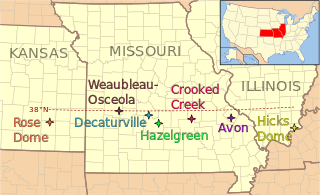 W
WThe 38th parallel structures, also known as the 38th parallel lineament, are a series of circular depressions or deformations stretching 700 kilometres (430 mi) across southern Illinois and Missouri and into eastern Kansas, in the United States, at a latitude of roughly 38 degrees north.
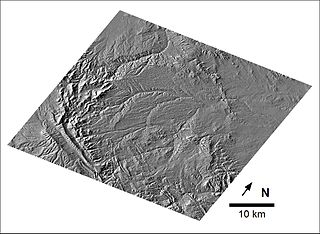 W
WThe Azuara impact structure is a structural feature of about 30 kilometres (19 mi) diameter, located in northeastern Spain, roughly 50 kilometres (31 mi) south of Zaragoza. The name is attributed to the small town of Azuara located near the center of the structure. The first hint to a possible impact origin was given by Wolfgang Hammann as early as 1980, and the first field evidence was provided by Johannes Fiebag in the early eighties. In 1985, Ernstson et al. published the occurrence of shock metamorphism, and Azuara was established (Grieve & Shoemaker 1994, Hodge 1994, Norton 2002 as an authentic impact structure. From stratigraphic considerations and paleontological dating, its age is estimated to be Upper Eocene or Oligocene.
 W
WBedout, or more specifically the Bedout High, is a geological and geophysical feature centered about 250 km off the northwestern coast of Australia in the Canning and overlying Roebuck basins. Although not obvious from sea floor topography, it is a roughly circular area about 30 km in diameter where older rocks have been uplifted as much as 4 km towards the surface and may mark the centre of a very large buried impact crater up to 250 km in diameter. The Bedout High was penetrated by two petroleum exploration wells in the 1970s and 1980s. It is named after nearby Bedout Island.
 W
WBloody Creek crater, which is also known as the Bloody Creek structure, is a 420-by-350-meter in diameter elliptical feature that is located in southwestern Nova Scotia, Canada. It is argued to be either a possible extraterrestrial impact crater or an impact structure. It lies between Bridgetown and West Dalhousie, Annapolis County, Nova Scotia, where the Bloody Creek structure straddles what was once a stretch of Bloody Creek. It also is informally known as the Astrid crater.
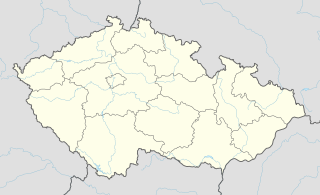 W
WThe Bohemian crater, also called Czech crater, is a working hypothesis that considers the Bohemian Massif as an approximately two billion year old potential impact crater of 260 kilometres (160 mi) diameter. This is contrary to the mainstream geological theory of plate tectonics, which explains the Bohemian Massif as the result of collision of independent continental units, occurring more than 300 million years ago.
 W
WThe Bow City crater is a potential meteorite impact crater located in southern Alberta, Canada.
 W
WBurckle crater is an undersea feature about 29 kilometres (18 mi) in diameter, in the southwestern Indian Ocean.
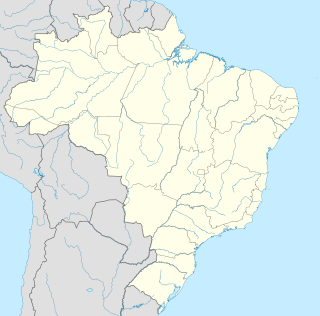 W
WCerro do Jarau crater is a 13.5 kilometres (8.4 mi) diameter circular feature in the Paraná Basin, Rio Grande do Sul in southern Brazil, close to the border with Uruguay. The Russian Academy of Sciences lists the structure as a probable impact crater.
 W
WThe Charity Shoal crater is a 1.2–1.4 kilometers (0.75–0.87 mi) in diameter circular feature that lies submerged beneath the northeast end of Lake Ontario about 12 kilometers (7.5 mi) southwest of Wolfe Island, and 25 kilometers (16 mi) south of Kingston, Ontario at about latitude 44° 02′ N and longitude 76° 29′ W. It is hypothesized to be a Middle Ordovician impact crater.
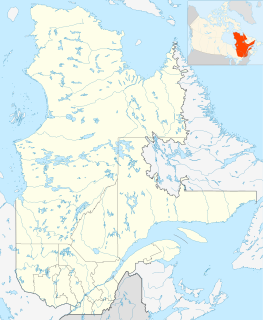 W
WThe Corossol structure, which is also known as the Corossol crater, is a circular, 4.3-by-3.9-kilometre in diameter, underwater bedrock feature that is exposed on the gulf floor of the northwestern Gulf of Saint Lawrence 20-kilometre (12 mi) offshore of the city of Sept-Îles, Quebec in eastern Canada. It is hypothesized to be a possible pre-Pleistocene, extraterrestrial impact structure. It lies underwater at a depth of 40–208-metre (131–682 ft). This underwater feature was found during the study of high-resolution bathymetric and sub-bottom profiler data collected south of the city of Sept-Iles in the northwestern Gulf of Saint Lawrence.
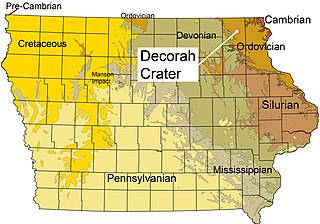 W
WThe Decorah crater, also called the Decorah impact structure, is a possible impact crater located on the east side of the city of Decorah in Iowa, United States. It is thought to have been caused by a meteor about 200 metres (660 ft) wide which struck during the Middle Ordovician Period, circa 470 million years ago.
 W
WThe Eltanin impact is thought to be an asteroid impact in the eastern part of the South Pacific Ocean during the Pliocene-Pleistocene boundary around 2.51 ± 0.07 million years ago. The location was at the edge of the Bellingshausen Sea 1,500 km (950 mi) southwest of Chile. The asteroid was estimated to be about one to four km in diameter and the impact would have left a crater approximately 35 km (22 mi) across.
 W
WThe Fried Egg is an informal name for an underwater geomorphic structure in the North Atlantic that is a suspected impact crater. This structure is at a depth of 2 kilometres and is about 150 km (93 mi) south of the Azores archipelago. It consists of a dome 300 meters high and 3 km (1.9 mi) in diameter that lies within a larger and roughly circular depression 110 m (360 ft) deep and 6 km (3.7 mi) in diameter. It is this morphology on which its informal name is based. Images that accompany media reports show the presence of a well-defined rim that surrounds the depression. These images also show a second but smaller circular depression, which also has a central peak, lying adjacent to the Fried Egg structure.
 W
WThe Hickman crater is a recently discovered meteorite impact crater, 16 kilometres northeast of the Hope Downs 4 Mine and 35 kilometres north of Newman in the Ophthalmia Range, Western Australia. It was discovered by Arthur Hickman, a government geologist with the Geological Survey of Western Australia, in July 2007. The discovery was made by chance while browsing Google Earth. A 2012 government scientific drilling project in the centre of the crater confirmed in 2017 the impact of an iron-nickel meteorite.
 W
WIturralde Crater is an 8-kilometre (5.0 mi) diameter circular geophysical feature in Madidi National Park in the Bolivian portion of the Amazon Rainforest, first identified from Landsat satellite imagery in 1985. The structure is located in a remote area in the Abel Iturralde Province of La Paz Department and was visited by researchers in 2002. Based on the presence of millions of glass beads, it has been hypothesised that the structure was created in the Late Pleistocene by the air burst of a non-impacting meteorite, similar to the Tunguska event in 1908.
 W
WJeptha Knob is the highest point in the Bluegrass region of Kentucky. It is located on private property in Shelby County, Kentucky, about eight miles east of Shelbyville near the hamlet of Clay Village and rises some 300 ft higher than the surrounding rolling farmland.
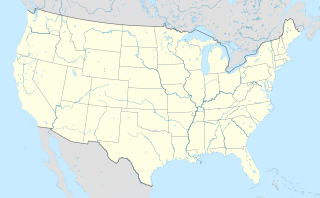 W
WThe Johnsonville crater or the Snow's Island crater is a circular geophysical feature situated at the junction of the Lynches River and the Pee Dee River in South Carolina, United States, which has been interpreted by some scientists as an impact crater. Snow's Island, at that point, is believed to be the upthrust formed at the center of the crater after the impact. The structure is approximately 8 miles (13 km) in diameter, but is not well defined at the surface. It was discovered by magnetic anomalies, supported by the study of well drilling cores. Supposed impact breccia was found in these cores. The Russian Academy of Sciences lists the structure as a proven impact crater, though the Earth Impact Database (EID) does not list it as confirmed.
 W
WKaveri Crater is an area identified by scientists in India which appears to have been created by an asteroid impact that occurred around 800 to 550 million years ago. The area lying between Nilgiris and Kodaikanal is in the southern peninsular India. A study indicated that the Kaveri crater has a diameter of 120 kilometres. Because of the size of the crater, Kaveri crater can only be visualized through satellite images. The crater is the fourth largest crater in the world.
 W
WKebira Crater is the name given to a circular topographic feature that was identified in 2007 by Farouk El-Baz and Eman Ghoneim using satellite imagery, Radarsat-1, and Shuttle Radar Topography Mission (SRTM) data in the Sahara desert. This feature straddles the border between Egypt and Libya. The name of this feature is derived from the Arabic word for "large", and also from its location near the Gilf Kebir region in southwest Egypt. Based solely on their interpretations of the remote sensing data, they argue that this feature is an exceptionally large, double-ringed, extraterrestrial impact crater. They suggest that the crater's original appearance has been obscured by wind and water erosion over time. Finally, they speculated that this feature might be the source of the yellow-green silica glass fragments, known as "Libyan desert glass", that can be found across part of Egypt's Libyan Desert. They neither conducted any fieldwork at this feature nor studied any samples collected from it. However, the Kebira Crater is currently not listed in the Earth Impact Database. Field trips to investigate the feature have found no supporting evidence. The "central uplift" clearly retains the horizontal bedding of the surrounding sandstone tableland, providing clear evidence against a possible impact origin.
 W
WLake Cheko is a small freshwater lake in Siberia, near the Podkamennaya Tunguska River, in what is now the Evenkiysky District of the Krasnoyarsk Krai.
 W
WLoch Leven is a fresh water loch located immediately to the east of the burgh of Kinross in Perth and Kinross council area, central Scotland. Roughly triangular, the loch is about 6 km (3.7 mi) at its longest. Prior to the canalisation of the River Leven, and the partial draining of the loch in 1826–36, Loch Leven was considerably larger. The drop in water level by 1.4 m reduced to the loch to 75% of its former size, and exposed several small islands, as well as greatly increasing the size of the existing ones.
 W
WThe Maniitsoq structure is a proposed 3 billion year old impact structure located in the Akia Terrane of the North Atlantic Craton, centred about 55 km (34 mi) south-east of the town of Maniitsoq, Greenland, at 65°15′N 51°50′W. However, the Maniitsoq structure has not been widely recognised as an impact structure, and the proposal was criticised for not meeting established criteria for recognising impact craters. Subsequent studies in the region have found no evidence for an impact structure, and a number of observations that directly contradict the earlier impact structure proposals. The Maniitsoq structure is not recognised as an impact structure by the Earth Impact Database.
 W
WThe Middle-Urals Ring Structure (MURS) is a circular structure located in the central Ural Mountains. The structure has a diameter in the range of 400 to 550 km and formed in the Precambrian prior to the Uralian orogeny.
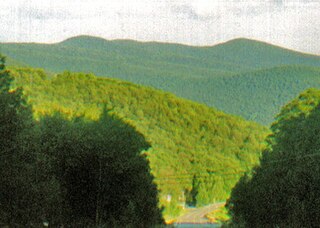 W
WPanther Mountain is one of the Catskill High Peaks, located in the Town of Shandaken in Ulster County, New York. At approximately 3,720 feet (1,130 m) in elevation, it is the 18th highest in the range. A combination of factors has led geologists to believe the mountain is on the site of an ancient meteorite impact crater.
 W
WPiratininga crater is a 12 kilometres (7.5 mi) diameter circular feature in the Paraná Basin of São Paulo State in Brazil. It is a possible impact crater, but further investigation is needed to obtain more information on the structure. The Russian Academy of Sciences listed the structure as a probable impact crater in 2017, but as questionable in 2019.
 W
WPraia Grande crater is a 20 kilometres (12 mi) diameter circular feature in the Santos Basin offshore Brazil. It is a possible impact crater that has been identified on 3D seismic by Petrobras in 2004. Further investigation is needed to obtain more information on the structure. The Russian Academy of Sciences lists the structure as a probable impact crater.
 W
WRamgarh crater, also known as Ramgarh structure, Ramgarh Dome and Ramgarh astrobleme, is a meteor impact crater of 3.5 kilometres (2.2 mi) diameter in Kota plateau of Vindhya range located adjacent to Ramgarh village in Mangrol tehsil of Baran district in Rajasthan state of India. When formally accepted as the third crater in India, its diameter size would be between the two already confirmed craters in India - Dhala in Madhya Pradesh with 14 km diameter and Lonar in Buldhana district of Maharashtra with 1.8 km diameter.
 W
WThe c. 80 km x 40 km sized Rubielos de la Cérida impact structure is located in Aragon, northeast Spain, north of Teruel and is considered a companion of the Azuara impact structure and part of a large multiple impact event, the Azuara impact event, that from stratigraphic considerations and paleontological dating happened in the Upper Eocene or Oligocene. The name is attributed to the village of Rubielos de la Cérida located in the central uplift of the most northerly part of the structure.
 W
WThe Shiva Crater is a geologic structure, which is hypothesized by Sankar Chatterjee and colleagues to be a 500-kilometre (310 mi) diameter impact structure. This geologic structure consists of the Bombay High and Surat Depression. They lie beneath the Indian continental shelf and the Arabian Sea west of Mumbai, India. Chatterjee named this structure after Shiva, the Hindu god of destruction and renewal. It is presently (2019) on the list of probable impact craters and is rated '1' based on three-step confidence level criteria of Anna Mikheeva of Russian Academy of Sciences, applied to the impact sites that have appeared several times in the literature and/or have been endorsed by the Impact Field Studies Group (IFSG) and/or Expert Database on Earth Impact Structures (EDEIS).
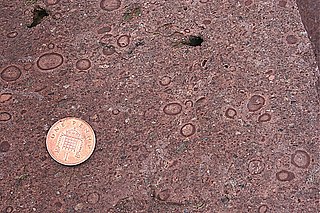 W
WThe Stac Fada Member is a distinctive layer towards the top of the Mesoproterozoic Bay of Stoer Formation, part of the Stoer Group in northwest Scotland. This rock unit is generally 10 to 15 metres thick and is made of sandstone that contains accretionary lapilli and many dark green glassy fragments of mafic composition.
 W
WUmm al Binni lake is a mostly dry lake within the Central Marshes in Maysan Governorate in southern Iraq. The 3.4 km wide lake is approximately 45 km northwest of the Tigris–Euphrates confluence. Because of its shape, location, and other details, it has been conjectured to represent an impact crater.
 W
WThe Victoria Island structure is a 5.5 km (3 mi) bowl-shaped structure buried in the shale sediments of the Sacramento-San Joaquin River Delta, 12 miles (19 km) west of Stockton, California. The circular structure is part of a former sea bed, and lies 1,490–1,600 meters (4,890–4,250 ft) below sea level.
 W
WThe Weaubleau structure is a probable meteorite impact site in western Missouri near the towns of Gerster, Iconium, Osceola, and Vista. It is believed to have been caused by a 1,200 feet (370 m) meteoroid between 335 and 340 million years ago during the middle Mississippian Period . It is listed by the Impact Field Studies Group as a "probable" impact structure.